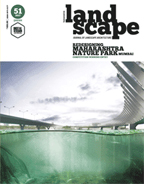Design
Going Forward: Landscape Architecture in India | Alpa Nawre
LA 51 |
|
Presently, the mismanagement of resources threatens to leave the future generations nothing to sustain themselves with. As India is well on its way to becoming the world's most populous country, it is imperative that landscape architects step in to tackle this oversight and steer the country in the right direction of sustenance and conservation.
In order to permanently establish and realise the true potential of our discipline and enable our cause, we must retain what is valuable in the historic paradigms and build and adapt them to provide for the needs of contemporary culture in India. |
|
 |
|
In the next fifty years, India is projected to be become the world's most populous country with a population of 1.6 billion. What does this mean for the landscape architecture profession in the country? It is a moment of pause and reflection for the profession as we examine the direction where we are headed, as a discipline and a country. With what are we welcoming our future generations? Piles of plastic? Polluted air and dirty water? Life in degraded environments with mismanaged resources is the normal human experience in many parts of India, where access to clean water, clean air, and efficient systems of waste disposal is a daily struggle. Water, especially, is a severely contested resource, both in terms of quantity and quality. Over 100 million Indians lack access to safe water, and diarrhoea causes 1600 deaths daily. Where water mafia and water dacoits are a grim reality, where suicides, murders, and streetfights over water scarcity are a serious issue, and where commuting back and forth from work could involve wading through chest or knee-high flood water, the problems associated with water management in India point to a crisis, which is only expected to get worse with impending climate change, rapid urbanization and population growth. In this context of mismanaged resources, landscape architects must step in to do what we can to restore and re-establish healthy relationships between humans and their environment. While some problems clearly fall outside the scope of a landscape architect, there are many issues that can be addressed through better water management landscapes. This is where the agency and action of landscape architects at both systems and site scale becomes critical, applicable not only to water but also to other contested resources.
How can landscape architects change societal and social paradigms in India? Consider Turenscape's Shenyang Jianzhu University Campus design that brings attention to societal values related to food production. Similarly, Houtan Park on a brownfield in Shanghai's Huangpu riverfront is a project that demonstrates the restorative power and ecological performance of a welldesigned landscape, and addresses with great aesthetic sensitivity, the region's extreme water pollution issues. Such projects are needed as desperately in India as they are needed in China for our ideas about food production, and our water pollution levels need no less attention than those in China. Landscape architecture practice in India may well benefit from taking a step from the nitty-gritty of every-day practice and taking a close, hard look at the larger picture about the 'kind of work' we do, instead of who or what or how we do it. The parks, gardens, malls and office landscape projects that landscape architects undertake in India, despite being well-designed, miss a big opportunity to engage with critical questions that deal with how we manage our resources at different scales. These issues often fall outside a landscape architect's traditional scope of work in India, which is a missed opportunity for the discipline.
|
|
|

|
|
|
|

|
| ISSUE NO: 51 |
|
 |
|
exhibition
ArvindTalati: A forgotten pioneer of Modern Indian Architecture
reports
IGBC's Green Landscape Summit 2016
Changing Climates, Evolving Landscapes, Isola-Goa 2017
Landscape and Conservation, SKNCOA-Pune, 2017
public participation
Public Participation in Design Works:
The Nimby, Banana and Lulu Syndromes
Harshad Bhatia
learning from the past
Clues on Street Network from Manasara:
Footpath or Sidewalks are not a British Legacy to India
Archana Sharma
directions
Going Forward: Landscape Architecture in India
Alpa Nawre
view from within
Identities and Boundaries
Geeta Wahi Dua
profile
Aesthetics, Utility and Environment: Practice of Ravi
Varsha Gavandi, Pune
competition
Redesigning Maharashtra Nature Park, Mumbai
landscape design
Transforming Urban Landscapes: Futala Lake, Nagpur
Deeproots Design
Revitalisation Of Derelict Urban Spaces:
Bundh Rejuvenation and Eco-Restoration of Urban Forest, Gurugram
VSPB Associates
Mana Resort, Ranakpur, Rajasthan
Parul Kiri Roy
Swastik Vatika: Marriage Venue, Anand
Karmavir Ghatge & Associates
Clover Fields: Weekend Home, Bangalore
Genesis Architecture
seeing the unseen
Panchtattvas: The Road Ahead
Dilpreet Bhullar
book review
An Inspiring Visual Reference
Book: #91 Residences Contemporary Indian Houses #3
review by Madhu Pandit
A Post-Colonial Paradigm of Universal Interest
Book: Cultural Landscapes of South Asia:
Studies in Heritage Conservation and Management
review by Narendra Dengle
landscape industry
Outdoor Lighting
Steve L. Aries
|
|